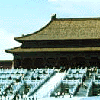


| The Forbidden City of Beijing was constructed
in the fifteenth century at the behest of the Emperor Yung Lo,
an emperor of the Ming Dynasty. Beijing, literally "Northern
City", is located in the north of China near the Mongolian border. It had
previously served as capital city of China under the rule of the Mongol
emperor Kublai Khan. Yung Lo ordered the remnants of the Mongol capital
destroyed and then raised a new imperial precinct along strict north-south
axix following the dictates of the Chinese science of planning, feng
shui.
In Chinese the Forbidden City is called the "Purple Forbidden City" since the color purple is associated with the polar star which in turn is associated with the symbolic stability of the emperor. The rectangular site is surrounded by a moat and guarded by towers. Inside, the Imperial Path follows the main north-south axis that bisects the site and leads through the Meridian Gate to the large ceremonial square facing the three main halls, the Hall of Supreme Harmony being the largest and most prominent. Behind these three hall are the residential palaces. The buildings of the Forbidden City are constructed of wood frames using the system of columns surmounted with brackets (called tou-kung) which create a flexible skeletal structure that supports the curved tiles roofs above. Color, design, and material of all components are dictated by treatises that specify the appropriate designs for every function on the site. |
FORBIDDEN CITY RESOURCES
|